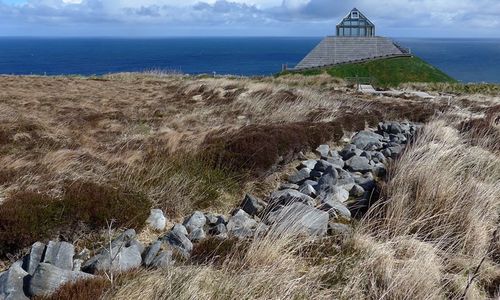Answers For Ceide Fields
Answers and detail explain for Ceide Fields
Explain
Ceide Fields

For my presentation today, I'm going to talk about the Ceide Fields in the northwest of Ireland, one of the largest Neolithic sites in the world. I recently visited this site and observed the work that is currently being done by a team of archaeologists there.
The site was first discovered in the 1930s by a local teacher, Patrick Caulfield. He noticed that when local people were digging in the bog, they were constantly hitting against what seemed to be 1rows of stones. He realized that these must be walls and that they must be thousands of years old for them to predate the bog which subsequently grew over them.
He wrote to the National Museum in Dublin to ask them to investigate, but no one took him seriously. It wasn't until 40 years later, when 2Patrick Caulfield's son Seamus, who had become an archaeologist by then, began to explore further. He inserted iron probes into the bog to map the formation of the stones, a 3traditional method which local people had always used for finding fuel buried in the bog for thousands of years. Carbon dating later proved that the site was over 5,000 years old and was the largest Neolithic site in Ireland.
Thanks to the bog which covers the area, the remains of the settlement at Ceide Fields, which is over 5,000 years old, are extremely well-preserved. A bog is 90 percent water; its soil is so saturated that when the grasses and heathers that grow on its surface die, they don't fully decay but accumulate in layers. 4Objects remain so well preserved in these conditions because of the acidity of the peat and the deficiency of oxygen. At least 175 days of rain a year are required for this to happen; this part of Ireland gets an average of 225 days.
The Neolithic farmers at Ceide would have enjoyed several centuries of relative peace and stability. Neolithic farmers generally lived in larger communities than their predecessors, with a number of houses built around a community building. As they lived in permanent settlements, Neolithic farmers were able to build bigger 5houses. These weren't round as people often assume, but rectangular with a small hole in the roof that allowed smoke to escape. This is one of many innovations and indicates that the Neolithic farmers were the first people to cook indoors. Another new technology that Neolithic settlers brought to Ireland was pottery. Fragments of Neolithic pots have been found in Ceide and elsewhere in Ireland. The pots were used for many things; as well as for storing food, pots were filled with a small amount of fat and when this was set alight, 6they served as lamps.
It's thought that the Ceide Fields were mainly used as paddocks for animals to graze in. Evidence from the Ceide Fields suggests that 7each plot of land was of a suitable size to sustain an extended family. They may have used a system of rotational grazing in order to prevent over-grazing and to allow for plant recovery and regrowth. This must have been a year-round activity as 8no structures have been found which would have been used to shelter animals in the winter.
However, archaeologists believe that this way of life at Ceide ceased abruptly. Why was this? Well, several factors may have contributed to the changing circumstances. 9The soil would have become less productive and led to the abandonment of farming. The crop rotation system was partly responsible for this as it would have been very intensive and was not sustainable. But there were also climatic pressures too. The farmers at Ceide would have enjoyed a relatively dry period, but this began to change and the conditions became wetter as 10there was a lot more rain. It was these conditions that encouraged the bog to form over the area which survives today.
So now I'd like to show you some ...
Complete the notes below. Write ONE WORD ONLY for each answer.
Ceide Fields• an important Neolithic archaeological site in the northwest of Ireland Discovery • In the 1930s, a local teacher realised that stones beneath the bog surface were once 1 (walls) . • His 2 (son) became an archaeologist and undertook an investigation of the site: - a traditional method used by local people to dig for 3 (fuel) was used to identify where stones were located - carbon dating later proved the site was Neolithic. • Items are well preserved in the bog because of a lack of 4 (oxygen) . Neolithic farmers • Houses were 5 (rectangular) in shape and had a hole in the roof. • Neolithic innovations include: - cooking indoors - pots used for storage and to make 6 (lamps) . • Each field at Ceide was large enough to support a big 7 (family) . • The fields were probably used to restrict the grazing of animals - no evidence of structures to house them during 8 (winter) . Reasons for the decline in farming • a decline in 9 (soil) quality • an increase in 10 (rain) . |
![[Forecast Q2-2025] - Biology lecture](https://static.helik.app/reading/8fd3d7d2-ccf9-47a3-8920-2e7a3b0d6607)
![[Forecast Q2-2025] - Living in the City](https://static.helik.app/reading/1a60bcf3-f3a7-4e9b-97a2-94d156a0de3b)
![[Forecast Q2-2025] - Student Union](https://static.helik.app/reading/fb443123-8c1d-447e-8c79-5a01650f4754)
![[Forecast Q2-2025] - Fruit-picking Job in an Orchard](https://static.helik.app/reading/e1968346-6c55-44ae-b8d3-f6a4fb7207b9)
![[Forecast Q2-2025] - University Crime Prevention](https://static.helik.app/reading/bdda593e-16d6-4c72-8a12-b116e917b27c)
![[Forecast Q2-2025] - Business Course](https://static.helik.app/reading/3308e282-99a6-4bcb-9d22-0b488701d968)
![[C20T1] - Choosing a restaurant](https://static.helik.app/reading/e9b21123-c43c-42fb-88b7-5d0be3a37e03)
![[YouPass Collect] - Car Club Scheme](https://static.helik.app/reading/6a749ba0-4cde-47fe-8260-f65b0599c3bf)